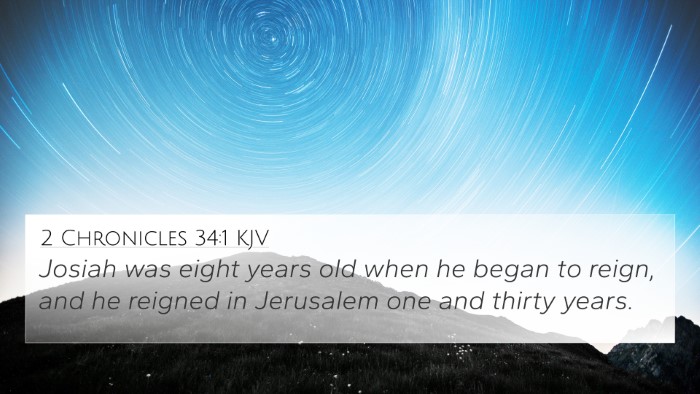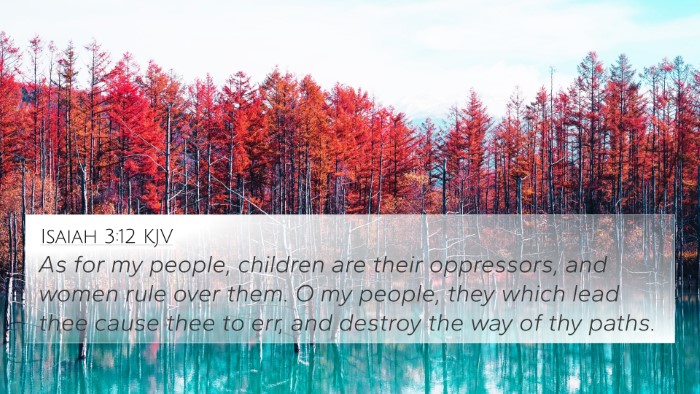Understanding 2 Chronicles 33:1
2 Chronicles 33:1 states: "Manasseh was twelve years old when he became king, and he reigned fifty-five years in Jerusalem." This verse highlights the commencement of King Manasseh’s reign over Judah, a reign marked by notable contrasts in faithfulness and apostasy.
Contextual Overview
King Manasseh is remembered as one of the most infamous kings of Judah due to his idolatrous practices and reversal of righteous reforms. The context of this verse establishes the stage for understanding the spiritual decline of Judah during his lengthy reign, which impacted the religious landscape profoundly.
Key Themes and Insights
-
The Age of Ascension:
Manasseh's age at ascension signifies youth yet also a significant opportunity for shaping a kingdom. This choice emphasizes the potential of young leaders and the responsibilities they bear.
-
Duration of Reign:
His lengthy reign of fifty-five years serves as a backdrop to the gravity of his decisions, showing how long-term leadership can influence a nation. The contrast with other kings who reigned shorter spans illustrates varying impacts on spiritual fidelity.
Commentary Insights
Matthew Henry
Matthew Henry notes that Manasseh's reign was filled with darkness and idolatry, yet also reflects on God’s patience and mercy. Henry emphasizes that even in profound sin, the possibility of repentance exists. He links this warning to the concept of divine judgment and mercy.
Albert Barnes
Albert Barnes observes that Manasseh’s ascension at such a young age led to challenges in governance. Barnes highlights how his reign caused spiritual decline, noting that leadership requires wisdom and divine guidance, missing from Manasseh's early reign. His insights invite readers to consider the importance of seeking God’s will in leadership.
Adam Clarke
Adam Clarke’s commentary elaborates on the repercussions of Manasseh’s idolatrous actions. Clarke emphasizes how his choices led to the moral degradation of the people, illustrating the relationship between a leader's fidelity to God and the nation's spiritual health. His interpretation stresses the interconnectedness of scripture and historical narrative.
Bible Verse Cross-References
In understanding 2 Chronicles 33:1, several interconnected Bible verses provide deeper insight:
- 2 Kings 21:1-16 - Details the idolatrous practices of Manasseh.
- 2 Chronicles 33:12-13 - Illustrates Manasseh's repentance and return to God.
- 2 Kings 21:23-24 - Highlights the consequences of Manasseh's sin for his descendants.
- Jeremiah 15:4 - References the calamities brought upon Judah as a result of Manasseh's actions.
- 2 Chronicles 28:3 - A contrast with King Ahaz’s evil actions in Judah.
- 2 Chronicles 7:14 - God's promise of healing if His people humble themselves.
- Exodus 20:4-5 - Warns against idolatry, reflecting the gravity of Manasseh's sins.
Linking Bible Scriptures
Through comparative Bible verse analysis, connections between Manasseh's reign and themes in the prophetic writings can be established. For instance, Isaiah 1:4 and Micah 1:5 address the spiritual state of Israel, allowing a viewer to understand the long-term implications of Manasseh's actions in light of prophetic warnings.
Inter-Biblical Dialogue
2 Chronicles 33:1 fuels an inter-Biblical dialogue about kingly responsibilities and divine expectations. This dialogue is evident when comparing the successes and failures of other kings, providing a broader understanding of leadership within the biblical narrative.
Tools and Methods for Bible Cross-Referencing
For those seeking to explore more about the connections within the scriptures, using tools for Bible cross-referencing such as a Bible concordance or a cross-reference Bible study guide could be invaluable. Methods like thematic Bible verse connections help enrich one’s study of scripture.
Conclusion
The message of 2 Chronicles 33:1 extends beyond historical accounts; it serves as a profound reminder of the importance of faithfulness to God and the consequences of departure from His ways. The analysis of this verse and its connections underscores the necessity of a heart aligned with divine principles, exemplifying how scripture interrelates through a web of themes, warnings, and divine truth.










